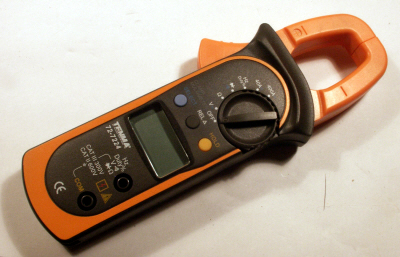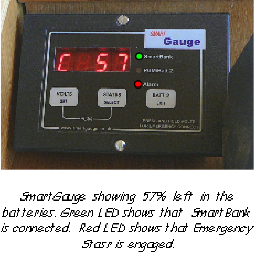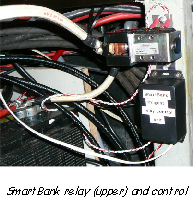|
Is your alternator up to
it? by Patrick Marks
Prologue
Many readers will be aware that I am a member of a syndicate which owns and
operates a ‘plastic cruiser’ in France. Bon Viveur II is now about four
years old and during this summer I fielded many texts and phone calls from
users with flat batteries. Our time on the boat is late April and everything
was fine then.
Act I, Scene 1.
The boat is fitted with a domestic bank of five 100 Ah batteries and has a
domestic alternator (DA) of 175 Amps output, which should recharge the
batteries from any state in less than a day’s cruising; should being the
operative word.
Scene 2.
It doesn’t. There were two other problems, as well. Firstly, the batteries
were arguably towards the end of their life and secondly, one user managed
to discharge them below 0% capacity which guarantees their destruction and
we had to procure a new set of batteries (Ouch!).
 Scene
3. Scene
3.
Why? After many months of cogitation and hassle, and endless theories from a
range of people, a friend, whom I shall call Henk to protect his identity,
said that without an ammeter to measure the actual current in the wires, a
proper diagnosis is extremely difficult. He is right.
Now, inserting ammeters into various wires is neither easy nor cheap, so I
hit on the idea of using a hand held clamp meter which I bought from
www.cpc.com for about £22. This has the benefit that it can be clipped
around various wires in turn to build a picture of what is, or isn’t,
happening and can be used for troubleshooting other installations later. (If
you buy one make sure it will measure DC amps, as many don’t.)
Act II, Scene 1.
A week in October became available, giving me the golden opportunity to find
out what was going on. So, there was only about 60 amps flowing into the
batteries even though they were ‘well down’ in terms of charge level, which
was never going to fill them up by mooring time because as they charged up
the current would only get less and less. Our 175 amp DA was not being
properly utilised, but again, why?
Scene 2.
I checked the voltage at the output terminal of the DA to see how much
‘push’ its got, and the answer is 14.00 volts, which might sound OK, but it
isn’t. A similar check of the SA’s output voltage gave 14.55 volts and when
this one was connected to the same batteries the current rose to 95 amps
which is the full rated output for this SA. What a difference half a volt
makes!
Does this mean that the big 175 amp alternator is faulty? Well, no, because
14.00 volts is the correct fixed output voltage according to the spec. sheet
downloaded from the internet.
Act III, Scene 1.
 By
great good fortune I had just installed a battery-paralleling relay which is
normally used for split-charge applications where you have one alternator to
charge two battery banks. This device is called SmartBank and is made by the
people who make SmartGauge which I have featured in these pages before.
SmartBank plugs into SmartGauge and is controlled by the same mini computer
and the same panel. (Don’t be put off by the word computer - most cars and
gadgets have them these days and its really simple to use: a stand-alone
version is available for those who must). By
great good fortune I had just installed a battery-paralleling relay which is
normally used for split-charge applications where you have one alternator to
charge two battery banks. This device is called SmartBank and is made by the
people who make SmartGauge which I have featured in these pages before.
SmartBank plugs into SmartGauge and is controlled by the same mini computer
and the same panel. (Don’t be put off by the word computer - most cars and
gadgets have them these days and its really simple to use: a stand-alone
version is available for those who must).
 I
had originally intended to use SmartBank to join both alternators together
to use the spare capacity of the SA when it has finished recharging the
starter battery. However, because the DA was running half a volt below the
SA, the latter does all the work (except when the kettle is on and the
inverter is drawing 130 amps!) but the nett result is that the domestic
batteries are now being charged up to 100% by the SA before the engine is
stopped at the end of the day. I
had originally intended to use SmartBank to join both alternators together
to use the spare capacity of the SA when it has finished recharging the
starter battery. However, because the DA was running half a volt below the
SA, the latter does all the work (except when the kettle is on and the
inverter is drawing 130 amps!) but the nett result is that the domestic
batteries are now being charged up to 100% by the SA before the engine is
stopped at the end of the day.
But that is not good enough because many users do not want to cruise all day
every day, so I still need to find a way for the DA to push in current at
the higher rate
Finale.
For the moment that is how things stand until I can find a way of raising
the output voltage of the DA, either by finding an alternative model, or by
fitting an external regulator. I am reluctant to try the latter because that
involves modifying the alternator itself, which would invalidate any
guarantee and make it non-standard so that replacement by any other person
would raise further problems, especially as the said boat is in France... I
am currently in discussion with Beta Marine on this topic and will let you
know what transpires in due course.
Postscript
A recent check of the alternators on Chouette showed that the SA is
regulated to 14.3 volts and the DA is 14.7 volts, which seems perfectly good
to me.
Patrick Marks. |



